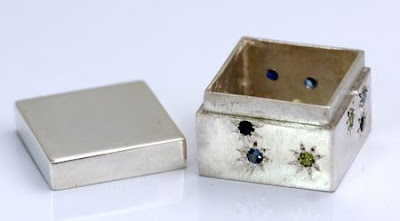
Recently all senior instructors for Art Clay World were asked to create 4 pieces showing their craftperson skills with Mitsubishi’s silver clay. The curriculum had changed since my certification as a senior instructor almost 2 years ago, and 4 new projects now replace some previous projects in the curriculum. Those 4 projects were thus a new requirement for all senior instructors who wished to retain their certification level.
One of the 4 pieces was required to be a hollow form brooch with faceted stones in three different sizes set into the clay after the clay dried. The piece also needed to have twice as many empty drilled holes as stone filled holes, 50 percent or greater of the surface area needed to be mirror finished, and there were more requirements…. Since this is a class demonstration piece which will sit in a box unworn, I used lab created faceted rubies and a lab created faceted amethyst.

I was happy to put my traditional stone setting workshop skills to work on metal clay. The skills for sizing and shaping a setting translate directly from cast or fabricated metal to dried metal clay.








